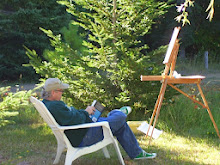Willa Cather wrote in O Pioneers!: “And now the old story has begun to write itself over there," said Carl softly. "Isn’t it queer: there are only two or three human stories, and they go on repeating themselves as fiercely as if they had never happened before; like the larks in this country, that have been singing the same five notes for thousands of years.”
Henry Herbert La Thangue was an English painter who was noted for his strong convictions and forceful personality. In An Autumn Morning, he gives us the land with a force and presence of its own, utterly independent, and perhaps even disdainful. It has an undeniable power over those who attempt to exert their will upon it. Yet, the story here is same old story repeating itself “as fiercely” as if it had never happened before.
Do we see in her face, the grand struggle between human agency and the larger forces; a relationship that goes deeper than mere control or influence? Is she, to some extent, an incarnation of the land, curiously empty of human emotion and personality?
At first glance, she seems to lack a personal inner life. But we know better. She is an individual with a massive, internal landscape.
At the same time, I can’t help but remember what Josephine Hart told us in Damage: “Our sanity depends essentially on a narrowness of vision--the ability to select the elements vital to survival, while ignoring the great truths.”












